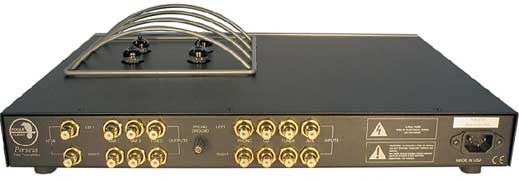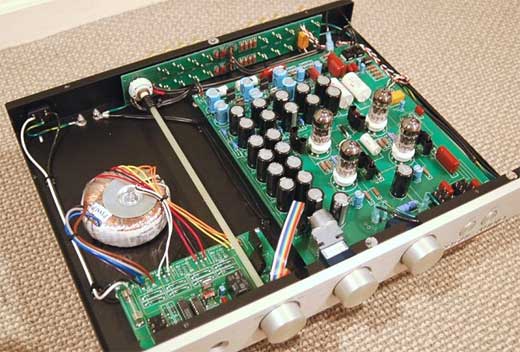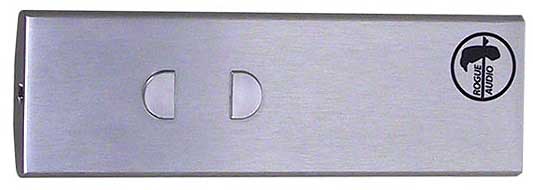 Introduction
Introduction
If I have my Greek mythology correct, Perseus was the slayer of Medusa, the serpent-haired Gorgon monster. Using his sword to view her reflection (because we all know a mere glance directly at her would turn you into stone instantly), he was able to slay her in her sleep.
Don’t ask me why this is important to the review of the Rogue Audio Perseus; I just thought it would add some color.
There is nothing frivolous however about the latest preamplifier from Rogue Audio, and in fact it’s quite easy to be seduced by the Perseus at $1,795, given their reputation for built quality.
Reviewing their website, I’m struck by the Rogue Audio Mission:
“At Rogue Audio we design and manufacture vacuum tube amplifiers. There is fierce competition in this market and we will only survive by delivering a superior product and superior service – we have the engineering and managerial talent to do so. Our core competencies are electrical, mechanical and production engineering, along with an overarching passion for excellence. These skills will be used to create products that offer outstanding value in the high-end marketplace.
Rogue Audio amplifiers will always be engineered to provide the four key elements of audio value:
? Superior Sonics
? High Quality and Reliability
? An Outstanding Appearance
? An Affordable Price
Our philosophy is simple – We will never design any amplifier that we would not purchase for ourselves.”
Specifications
- Solid State, Tube, or Hybrid: Mu-follower Tube Design
- MFR: 5 Hz – 50 kHz ± 1 dB
- THD: 0.1%
- Four Inputs, Three Outputs
(RCA) - Output Impedance: 450 Ohms
- Maximum Output Voltage: 20
Volts RMS - Dimensions: 4.5″ H x 18″ W x
14.5″ D - Weight: 22 Pounds
- MSRP (USA): $1,795
The Design
Perseus offers an immediate visual impression – firstly how very thin or low profile the chassis is, and secondly, the elegantly arched protective cage covering the compliment of tubes. The unit stands deceptively 4 ½” high including the cage.
Under the removable cage are four line stage 12AU7 tubes peeking (and venting) through the top of the unit. The cage can be removed by first removing the cover and unscrewing the cage from below.

The faceplate is carved out of solid aluminum and is about 3/8″ thick. The simply styled front is dominated by three larger knobs, including an input selection, volume, and balance controls. Each knob spins easily and feels solid in your fingers. Additionally, on the front are a power on/off button which also lights up a glowing blue light on one side, and a mute and bypass button which reside just above the etched logo on the other side, more on that later.
Perseus is a four input preamplifier, and the rear sports unbalanced heavy-duty gold plated RCAs labeled Phono (with ground), CD, Tuner, and Auxiliary. Three outputs are possible with two variable and one fixed – controlled by the front volume as you may connect both an amplifier or subwoofer and a fixed output (uncontrolled) for recording.

A detachable power cord completes the rear design, and Rogue Audio recommends that both the Perseus and your power amplifier are plugged into the same outlet to prevent ground loops.
The Perseus allows adjustments to phono cartridge loading (resistance and capacitance) and gain by removing the cover and setting your preference. You can select moving coil or moving magnet cartridges via switches on the circuit board.
The phono stage has a specified gain of 40 – 65 dB, yet I found it amazingly quiet, attributable to the mu-follower circuit design.
Further, the Perseus meets the RIAA equalization specification which is essentially a vinyl recording adjustment made during playback. Because low frequencies require a larger slot for the stylus possibly causing it to jump, recording engineers reduce the lower frequencies. During playback those lower frequencies are amplified to the correct volume.
Under the hood, what you will find is the engineering Rogue Audio puts into this sophisticated American made preamplifier. Perseus boasts a “massive power supply, ultra-high tolerance resistors, polypropylene capacitors, and gold/ceramic tube sockets”.

Home Theater Bypass
Give the designer credit for addressing the home theater enthusiast who might want to integrate the preamp with their system by offering an HT connection as well, related to that bypass feature button found on the front. Essentially it allows the integration of the Perseus for two-channel with CD, or a phono source with a processor for multi-channel. By activating the Bypass, the input is routed through the preamp directly to the processor. The analog benefits are of course the lure in this setup, and I love the feature.
Setup
The question always becomes, to pair up a tube preamplifier with a tube amplifier or solid state amplifier. Of course the direction I took was to use a solid sate amplifier. Why? Without getting into a dissertation about the benefits of either tube or solid state, the combination can bring the best of both worlds together. The wonderful mid-range from tubes combined with a low distortion and deep bass driving amplifier will bring out the most of your speakers.
I paired the Perseus then with a transistor amplifier from Audio Design Associates (ADA) I had on hand from a previous review. Although the fan noise from the ADA unit interfered with some of the quiet periods, the Perseus nevertheless benefited from the collaboration.
Input sources included a turntable from Marantz, the TT-15S1, a McCormack universal player with the Reference 205/2 speakers from KEF, Alpha-Core interconnects and speaker cables from Goertz. All were plugged into a Torus 20 amp power conditioner.
Rogue Audio sends out the Perseus fully burned in, which also means it must go through some lengthy testing prior to leaving the shop.
The Perseus has a “slow start turn on sequence” which preserves the tubes and power source. It takes about 10 seconds once switched on before the voltage turns on and another 10 seconds before the outputs “disconnect from ground”.
This of course gives you plenty of time to get acquainted with the simple yet hefty remote control which only controls volume up and down.

Allow me one minute gripe: using the remote is a bit hard to get the volume just where you want as it’s either just too loud or too low. There seems to be a lingering delay as the volume knob continues after you stop pushing the button on the remote.
The Sound
Immediate impression, this thing is very quiet! I had expected a bit more noise, yet the Perseus relegated any such “hiss” to extreme volume with nothing playing – and still I had to leave my chair and place my ear to the drivers.
On vinyl, Nat King Cole’s LP, After Midnight is in itself a wonderful moody recording from 1956. Perseus presents Nat and the Trio with a full range – his voice is smooth yet throaty, forward, and airy. The instruments from Stuff Smith’s violin, and Nat’s piano playing are nicely articulated, alto sax, trumpet, and trombone sufficiently brassy. This is an accomplished ensemble. Perseus made this two-album LP so much fun!
Of course CDs are where it’s at, right? Yo-Yo Ma’s Vivaldi’s Cello with the Amsterdam Baroque Orchestra is an easy listen and not all that complex to enjoy. Of course if you love the cello as I do, Perseus delivers it with warmth and musicality. Believable “live” bass is tight and fast. Highs are nicely extended and crisp, yet the edges are softer, relaxed.
An ultimate male voice demonstration disc from Cantus, Against the Dying of the Light, is an emotional CD with tenors, baritones, and basses recorded in a chapel, in Minnesota. Perseus reproduces the group with complex voice layers and a stage presence, placing me several rows back.
I wondered what Perseus would do with more modest speakers, say monitor type and how it may exploit or bring out the full potential of the speaker. Auditioning the new BLS bookshelf from Outlaw Audio, I found the emphasis was on detail.
Perseus pushed the dynamic of the tweeter, yet I was struck by the depth and range from deep bass and a full midrange – a wonderful match it seems with many speaker types, is my point.
Perseus unveiled Marta Gomez’s pretty CD Cantos De Agua Dulce with a natural ease, her voice natural and sweet with background vocals forward. Percussions absolutely dynamic and spatial and more pronounced. Very much like the cello, the guitar is warm without being too “woodsy”.
Almost completely opposite to Marta Gomez’s silky voice is bass singer Kurt Elling – Live in Chicago with its stage nuances and club atmosphere. No DSP here, this is a club concert. Perseus reveals Elling’s voice so precisely you almost sense the few times he may be off key, after all this is live! Instruments on the other hand are meticulous – Perseus presents the piano with such vigor and attack! Acoustic bass guitar is once again forward, almost in your lap.
I’d be remiss if I didn’t challenge Perseus with a difficult classical orchestra – Mahler’s romantic, poetic and tribute to nature with Symphony no. 1, specifically the CD Blumine, with David Zinman, and the Tonhalle Orchestra Zurich. Mahler intended the sense of distance to some of the instruments, trumpets, and violins and the third movement is dream-like and provocative – credit the recording, yet Perseus clearly delivers, finished, and polished.
Conclusions
Lately, I’ve enjoyed reviewing the convenience of integrated amplifiers, and with so many exceptional pieces, I’ve shunned the need for a separate preamplifier. Oh, what I was missing! The phono stage, especially, can certainly make the difference on a modest turntable, elevating it to “much better”.
Those who simply cannot find space for a separate two-channel system can add the benefits from this analog source easily with the HT Bypass feature. Although I spent most of my time with the Perseus in a separate room with a two-channel system, placing it in my solid-state surround sound greatly improved the system with more character, dimension, texture, and an overall timbral balance. It’s literally painful to remove it from that system. If your motive is the same as mine, you want the pure enjoyment of music.
You’ve heard this before about components and you’ll hear it again – the Rogue Audio Perseus is a bargain for a preamplifier of this caliber.


